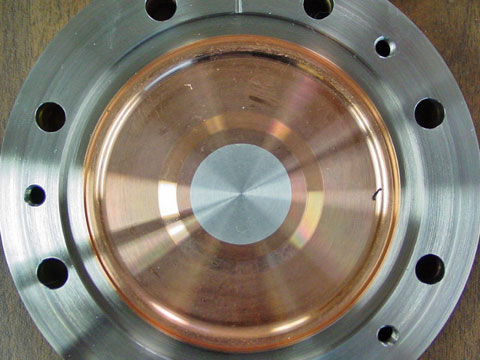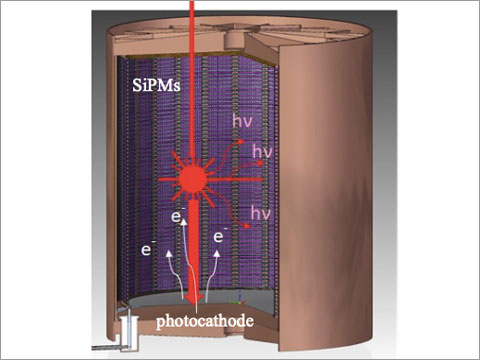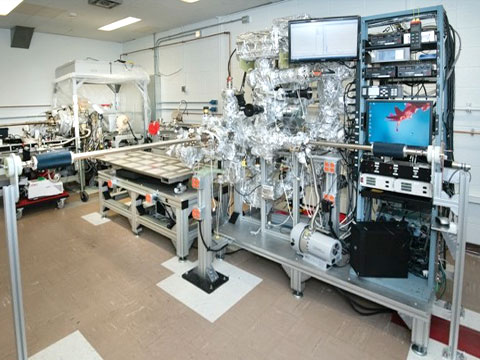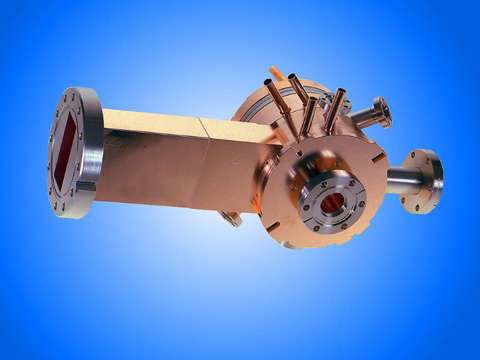System Development
Electron Source Development
For the past three decades, the Instrumentation Department has been at the forefront of generating electron beams with high brightness for collider and photon source applications. Our surveys of materials have led to the worldwide adoption of copper (Cu) and magnesium (Mg) for high-peak-brightness electron beams. We were the first to investigate the use of ultrashort laser pulses and associated field and plasmon processes, leading to enhanced photoemission. Our patented cathode preparation techniques resulted in a 100- to 10,000-fold improvement in quantum yield. These efforts have also led to record-setting cathode lifetimes, applications beyond high-brightness electron injectors, and a fundamental understanding of photocathode material properties and fabrication.
Our Capabilities
- Survey and selection of a variety of materials—including metals, semiconductors, bulk insulators, and topological insulators—as electron sources customized for different applications
- Design, construction, testing, and commissioning of ultrahigh-vacuum (UHV) and extreme-high-vacuum systems with thermal and electrical feedthroughs for cathode fabrication and transport
- Design, construction, testing, and commissioning of high-purity cryogenic systems
- Deposition of thin films and characterization of material composition and crystalline properties using x-ray sources at synchrotron beamlines
- Growth and optimization of bialkali antimonide photocathodes for applications requiring low-emittance electron beams (e.g., ultrafast electron diffraction, energy recovery linacs, free-electron lasers) via a custom-designed mobile system for the simultaneous fabrication and x-ray characterization of these materials under vacuum—the only such system in the world
- Characterization of the surface properties (e.g., smoothness, composition) of materials via atomic force microscopy and scanning electron microscopy
- Preparation of substrates and metal surfaces in situ (heating and laser cleaning) and ex situ (polishing and ultrasonic cleaning)
- Development, use, and maintenance of photon sources: continuous-wave and pulsed-light sources and laser systems with wavelengths spanning from 1 to 0.2 μm, pulse durations ranging from microsecond to femtosecond, and repetition rates extending from continuous to a few tens of Hz
Case Studies
Accelerator electron source

Back plate of an S-band RF gun with an Mg cathode.
Our investigation of cathode materials led Brookhaven’s Accelerator Test Facility (ATF) to use Cu, Mg, and niobium (Nb) in its S-band radio-frequency (RF) guns to deliver high-brightness electron bunches. A similar gun, illuminated by a femtosecond (fs) ultraviolet laser, routinely produces fs electron bunches at the ATF. These bunches have been used to test novel approaches for increasing the accelerating gradient, improving the brightness of photon sources, and performing ultrafast electron diffraction. Numerous institutions around the world—including the Linac Coherent Light Source and the Japanese High-Energy Accelerator Research Organization (KEK)—are using these cathode materials and our cleaning procedures.
Calibration for particle physics

A conceptual schematic of the TPC (cylinder) with a gold photocathode (bottom) and scintillating-light detectors made of silicon photomultipliers, or SiPMs (sides).
We developed gold photocathodes and immersed them in liquefied argon and xenon. By irradiating the photocathodes with a laser, we generated electron bunches with excellent stability and precise timing synchronization and measured the transport properties of these electrons in the noble liquids. This technology is suited for charge calibration in noble-liquid time-projection chambers (TPCs), detectors being designed for particle physics and dark matter experiments such as the Deep Underground Neutrino Experiment (DUNE), MicroBooNE, DarkSide, and the next Enriched Xenon Observatory (nEXO). The laser light can also be used to simultaneously calibrate and monitor scintillating-light detectors in TPCs. The synchronous measurement of electrons and photons is key to identifying rare particle interactions (e.g., between neutrinos and argon) in these experiments.
Photocathodes for electron cooling

A cathode production and transport system for low-energy electron cooling.
Beam cooling increases the collision rates in ion colliders, enabling scientists to explore new physics regimes. For electron cooling at Brookhaven’s Relativistic Heavy Ion Collider (RHIC), we selected alkali antimonide photocathodes as the electron source material. These photocathodes have high electron yield at visible wavelengths and days of lifetime, even while delivering up to 30 mA average current. To ensure uninterrupted operation of cooling experiments, we developed multiple deposition systems and UHV multicathode transfer systems. In 2019, the Low Energy RHIC electron Cooling team used electron bunches generated by the photocathodes in a direct current injector to cool the first gold ions at RHIC. Electron cooling approaches are also being proposed for beam cooling at Brookhaven’s future Electron-Ion Collider.





